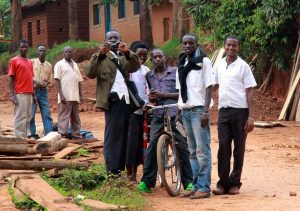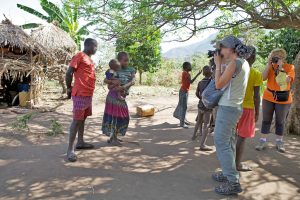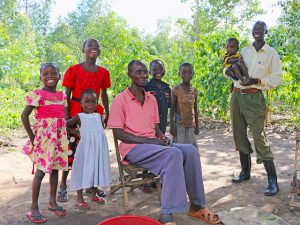#Hashtagging Poverty
Others, RelationshipsContributed by: Food for the Hungry Canada
Travelling is the best.
It’s when I enjoy some of my craziest adventures, taste some of the most unique flavours, and take some of my best photos.
I gotta say, as someone who witnessed the advent of camera phones (and was skeptical about how useful they could be), I love how I can now whip out my cell to share and immortalize memories.
In fact, travelling is why I have an Instagram account at all—more than half of my own posts are from trips (even day-trips).
I scour Instagram almost daily to see what my online community is seeing. And I easily receive the most likes from things I post while out and about in the world. I suspect you experience the same? There’s something special about travelling that makes me want to show it off to my online world and enjoy the affirmation in return.
Until one incident made me sick to my stomach.
I was already a little queasy, careening down the highway coming out of the Burundian mountains. The driver was not taking it easy as he flew past transport trucks and other taxi vans headed into the city of Bujumbura. I was enjoying the sights, leaning out the passenger window, camera in hand, snapping photos.
But then my stomach really turned.
As I was leaning head—out the window—I was suddenly shouted at, followed by aggressive gesturing. A group of men by the roadside started hollering at me as we rounded the bend, then lunged at the van as we passed, yelling, arms waving, clapping at me. I think one man even threw a lump of charcoal. It was my first time in Burundi, and this was destroying my positive experience.
As a foreigner, there’s so much to see along the road’s edge. Rickety stands loaded with pineapple. Tufted chickens and spotted goats. Men pushing bicycles overloaded with banana clusters. Rows of tattered white bags of charcoal for sale. Women effortlessly carrying yellow water jugs on their heads. Teenagers in school uniforms sauntering barefoot to class. Toddlers peeking from behind skirts. Mud homes.
In that shocking moment, I couldn’t understand why the aggression. Why the disrespect?
I was offended. I didn’t feel welcome or safe anymore. No more leaning out the window enjoying the sights. And I was confident that I certainly couldn’t have provoked such a rude and violent response.
But looking back now, I know deserved it. When overseas – on vacation, a mission trip, volunteering, or otherwise – it’s easy to get excited about everything in sight. And if you’re any kind of amateur photographer or Instagrammer, you’re likely occupied with thoughts about lighting, angles, settings, taking multiple shots, and most of all, likes. At that moment, your idea of courageous is asking someone to scoot into the light or look in a different direction.

Rarely do we stop to think, should I take this photo at all?
I later learned these men were outraged because they suspected I would use the photos for personal or commercial benefit. Using something of theirs – their portrait, their likeness, their work and livelihood – to make money for myself.
Um, I think that’s pretty much the definition of exploitation, isn’t it?
I was suddenly faced with my own ignorance, and also my deep-seated selfishness.
There I was, a white, privileged Westerner visiting downtrodden Burundi with my high morals, volunteering my time and money, wanting to help the poor people, but also wanting to get my photos out there… #poverty #roadside #roadsidesales #cutekids #helptheleastofthese… But ultimately I was doing as I pleased, taking what I wanted, assuming I could and should, and at the end of the day slapping an altruistic motivation on all of it. That was an uncomfortable reality to face.
Even if we only get a few likes, our photos are not innocent. If they aren’t doing much good, then it’s quite possible they’re doing harm (because they will do something!). How so, you ask?

Consider the images that come to mind when you think about, say, sub-Saharan Africa. Over the years, it’s not like the shots taken by Western visitors and media have done Africa’s reputation any favours. Consider the content of many of these photos (a quick Google search will show you what I mean). Too many images of dusty landscapes, dilapidated mud huts and tattered tents, stoic guerrilla extremists, naked belly-bloated children, abject women sitting in the dirt, sickly elders. Is this the story Africa wants shown over and over again?
It seems some of our friends in developing communities have had enough.
Having spent more time in Burundi since that initial shocking experience, I find the people there incredibly kind and hospitable; those men wouldn’t have acted that way without reason. They understand the potential for exploitation and how it ultimately affects them personally, and they were pushing back.
Why should some snap-happy volunteer tourist gain from their daily, back-breaking jobs or daily trials? Are they objects to be hashtagged? While alarming and aggressive, it was a wake-up call.

This experience is totally foreign to me.
I’m not talking about being yelled at in Burundi; rather, I’ve never been the tourist sight. I’ve never been pounding out emails in my poorly ventilated office on a hot day and had an entourage of khaki-clad foreigners walk in to offer me some water and take snaps of my thrift-store sneakers and partially dead desk plant. Or while shirtless and scrubbing the algae off the deck railings of my dated apartment building, had a tour bus of teens pull up to the curb to take photos and drive off shaking their heads while comparing images on their social media feeds. Safe to say, the experience would leave me feeling like a targeted object – it might even leave me feeling violated. I’d sure hope those photos wouldn’t get around.
Is that the sum total of who I am? An overheated employee or dusty shirtless man in an unsavoury location?
In Toxic Charity, author Robert Lupton tells a story of educator and community advocate John McKnight. While addressing a large crowd, McKnight introduces himself by his balding head, failing eyesight, embarrassing surgeries, jobs he had lost, and other flaws. His introduction has the audience bewildered and questioning his credibility.
It turned out to be a fantastic way to drive home his point.
How you introduce someone immediately triggers value judgements. And today, we introduce people with images. Showing a person or community at their worst, highlighting their misery instead of their strengths, is no way to honour a person.
How would I feel if my less-attractive bits were broadcast to the world – my receding hairline, surly mood swings, the cracked headlight in my brown Jetta, an account of uncompleted projects or failed relationship. Yes, those disappointing bits are part of who I am, but they’re hardly a complete picture. If that’s all someone ever sees about me, I’m not only robbed of some credibility but worse yet, I’m robbed of my dignity.

I believe that everyone is created by God.
That’s a mind-blowing fact not to be glossed over – the sovereign of the universe designed each person and acted to redeem each life. What worth! Even if you don’t agree with this belief, you will most likely still assign others the same value you would give yourself. Each person, no matter what their circumstances, deserves to be treated accordingly.
If our shutter releases, filters, posts, and hashtags undermine human dignity, we need to change what we are doing.
I work in the nonprofit world where fundraising is paramount. Choosing photos presents a dilemma. It’s no secret that depressing or dramatic images get attention and communicate a desperate need that then motivates giving. An emotional reaction is a powerful thing, and can often lead to action. But eliciting a compassionate response does not need to be about showing the kid with flies in the eyes. It’s about showing a complex, personal reality and telling a story – a reality that needs a response – and respecting those whose story is being told. Rather than provoke action by compromising someone’s dignity, why not introduce our audience to each person’s unique story and create excitement for the potential to help them change that story and realize their potential.
As someone taking a photo, we must challenge ourselves to really see people as individuals, not product shots. We have to hold ourselves to a higher standard, to have real integrity. To be courageous enough to let go of photos that don’t honour the subject. Images are powerful, and we need to use our power for good.
How do we do that? Here are 5 quick checks to hit before you let the shutter fly.
1. Zoom in and check your white balance.
Why do you take pictures? What do you do with them? Is it about getting the likes, or capturing a startling image? Are you a person of privilege, viewing daily life or trips overseas as one big vacation, where you can snap as you please?
But then are you forgetting to give priority to the person in your picture, and serving yourself first? Be honest with yourself and your motivations. Think about how you might be acting and might be perceived.
2. Crop out bad behaviour.
Stop consuming. The image of another person or the components of their life is not yours to hashtag or stream.
It’s easy to justify our compromises. We tell ourselves it’s only a quick snap, no one will notice so no need to ask permission. And then when using the images, we figure that no one knows these people anyway, so it doesn’t matter how I use their picture. Or we decide it is a necessary sacrifice, a means to an end, that could ultimately benefit the many. But every time we compromise like this, we undermine someone else’s choices and only perpetuate the problem.
3. Use the right lens.
Is the answer to never taking photos of any situation that could be perceived as negative? Not necessarily; representing a reality sometimes means showing some sad stuff. But better yet, also try to capture people’s strength, perseverance, and joy, even when their outer circumstances don’t look hopeful.
4. Adjust your shutter speed.
Doing things right only needs to take an extra moment. Pause and ask yourself if you should capture that shot. Get permission from those you take shots of (here’s a form I sometimes use). Have a few kind, opening words ready to engage people with – so you can get to know them and their story, so you can represent their reality and their potential.
Real integrity is asking permission. It’s letting the shot go when they say no. It’s connecting with the people whose lives are being captured on film and immortalized on the internet. Real integrity is having the humility to share in their reality, their potential, and their beauty.
5. Push some buttons.
No doubt, you have friends and family who are also snap happy. Many people do not realize how their posts are being perceived (beyond the likes) and the power of their photos. Even their one or two travel photos adds to the larger whole of photos that misrepresent people. Without passing judgement, share with them any personal convictions and behaviour changes you are making with your photos.
Several years ago I visited the dump in Tijuana.
Local friends regularly visit the dump’s many garbage pickers with food supplies to offer a fresh meal and a kind conversation as a way to build a friendship. Tijuana is a city characterized by its sprawling ghettos, so only the most disadvantaged or outcast end up at the dump.
In a gully alongside the mountains of trash, the poorest of the poor had built up a small shanty town from old pallets, torn tarps, and automotive bits. There we were introduced to one of the elderly couples my friends had been getting to know.
Naturally, I wanted to capture the memory with a photo.
We’d refrained from taking many photos in the camp, not wanting to make a spectacle of their situation, or hinder the reputation of our friends. So, we asked the couple if they’d mind joining us for a photo, and they humbly clustered with us for the classic posed shot. I showed them the picture on my camera’s digital screen, and it was met with big smiles as they leaned in for a good look. They’d only seen a photo of themselves a few times before. This couple certainly did not own a camera, nor did we notice any personal photos in their sparsely furnished hut.
A brainwave hit, and I asked if they would like a photo of only them, a portrait that we would print and deliver via our missionary friends.
They were surprised by the offer, but then enthusiastically agreed and proceeded to straighten their shirts, hold their heads up, and stand tall. The change in disposition was palpable. The rest of the day I visited other families who were pleased with the opportunity to have taken a family photo of their very own.
It became one of my most meaningful memories as a photographer.

Written by: Michael Prins

